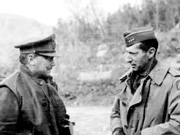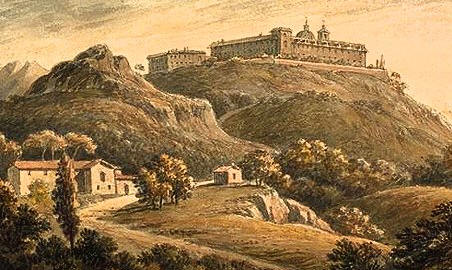|
|
|
BERNARD CYRIL FREYBERG il dentista |
|

|
|
|
BERNARD CYRIL FREYBERG il dentista |
|
Bernard Cyril
Freyberg was born at Richmond, London, on 21 March 1889 son of James Freyberg, a
surveyor, and Julia Hamilton. He came to Wellington (NZ) with his family in 1891
and received his early schooling from his mother. Although not academically
inclined, he made his mark as a swimmer (100 yards champion in 1906 and 1910).
He also played competitive water polo, and was a keen yachtsman. He was
apprenticed to a Wellington dentist and admitted to the Dentists’ Register of
New Zealand on 22 May 1911. Freyberg’s first military involvement had been in
the school cadets at Wellington College, while he was persuaded by the commander
of the local T. Force company, Stephen Allen, to become one of his subalterns. He
unsuccessfully sought a commission in the New Zealand Staff Corps in 1912, and
from January 1913 served as a lieutenant in a senior cadet company.
Freyberg nasce a
Richmond (Inghilterra) il 21 marzo 1889. All’età di due anni la famiglia si
trasferisce in Nuova Zelanda dove eccelle nello sport (Campione nelle 100 yarde
di nuoto nel 1906, velista e pallanuotista) piuttosto che negli studi. Ma nella
sua vita non c'è solo sport: diventa aspirante dentista nel 1911 cominciando
dalla assistenza alla poltrona. Il suo fortuito incontro con Stephen Allen, comandante della forza militare territoriale (compagnia locale) è
l’inizio della sua carriera alla Accademia Wellington. Sfuggitogli un incarico
nei corpi di stato maggiore, presta servizio come ufficiale in una compagnia di
cadetti anziani.
In March 1914 he left Wellington for San Francisco. After some weeks of
indecision, Freyberg went south to Mexico, and may have been involved in the
civil war then raging in that country. In London when war broke out in 1914
Freyberg met and persuaded the First Lord of the Admiralty Winston Churchill to
give him a commission into the Hood Battalion. Having served during the defence
of Antwerp with the Royal Naval Division in August 1914 Freyberg was posted to
Gallipoli where after a remarkable performance during the initial landings he
served until the Allied evacuation. He was badly wounded again in July, and left
the peninsula when the division was evacuated in January 1916. Transferring to
the British Army, Freyberg was posted to the Queen’s Royal West Surrey Regiment,
but remained seconded to the Royal Naval Division, with which he proceeded to
France in May 1916. During the final stages of the first battle of the Somme, he
so distinguished himself in the capture of Beaucourt village that he was awarded
a Victoria Cross; he was again severely wounded in this action and evacuated to
Britain.
 Nel marzo del
1914 lascia l’Australia per gli Stati Uniti in cerca di avventure. Qui, nel sud
degli States, viene arruolato per la guerra (civile) in corso in Messico.
Quando, pochi mesi dopo, anche in Europa deflagra il conflitto riesce, coi buoni
uffici di Churchill, ad avere un incarico nelle truppe anfibie della marina
prima ad Anversa poi a Gallipoli dove viene ferito l’anno dopo. Al rientro della
convalescenza viene assegnato al reggimento Queen’s Royal del West Surrey
impegnato nella Somme. Qui si distingue nella occupazione del villaggio di
Beaucourt che gli frutta la Victoria Cross ma anche una seconda grave
ferita.
Nel marzo del
1914 lascia l’Australia per gli Stati Uniti in cerca di avventure. Qui, nel sud
degli States, viene arruolato per la guerra (civile) in corso in Messico.
Quando, pochi mesi dopo, anche in Europa deflagra il conflitto riesce, coi buoni
uffici di Churchill, ad avere un incarico nelle truppe anfibie della marina
prima ad Anversa poi a Gallipoli dove viene ferito l’anno dopo. Al rientro della
convalescenza viene assegnato al reggimento Queen’s Royal del West Surrey
impegnato nella Somme. Qui si distingue nella occupazione del villaggio di
Beaucourt che gli frutta la Victoria Cross ma anche una seconda grave
ferita.
The following year (1917) brought Freyberg a promotion to Brigadier-General - making him at 27 the youngest in the British Army. He was given a brigade and then a divisional (29th) command. By the armistice he had been wounded on nine occasions. Early in 1919 Freyberg was granted a regular commission in the Grenadier Guards and settled into peacetime soldiering. From 1921 to 1925 he was a staff officer in the headquarters of the 44th Division. He suffered health problems arising from his many wounds, and as part of his convalescence he visited New Zealand in 1921. On 14 June 1922 he married Barbara McLaren (née Jekyll), a widow with two children; they would have one son. In the general election of that year he stood unsuccessfully as a Liberal candidate. After a further staff appointment, at Headquarters Eastern Command, Freyberg was appointed to command 1st Battalion, Manchester Regiment, in 1929. Staff appointments in Southern Command (1931–34). With his promotion to the rank of Major General in 1934, at the age of only 45, he seemed headed for the highest echelons of the army. However, medical examinations prior to a posting in India revealed a heart problem. Despite strenuous efforts to surmount this, Freyberg, who was made a CB in 1936, was obliged to retire on 16 October 1937.
L’anno dopo, 1917, è già Brigadiere alla sola età di 27 anni. Caso più unico che raro anche in tempo di guerra in cui le promozioni accelerate sul campo creavano carriere fittizie destinate a scomparire al termine del conflitto. Dal 1921 al 1925 è nello stato maggiore della 44 divisione. Le numerose ferite di Guerra (altre 9 oltre quelle dette) gli causano problemi di salute. In occasione di un suo ritorno in Nuova Zelanda sposa una vedova con due figli. Ricopre diversi incarichi di comando e di S.M. fino al 1934 quando viene promosso Maggior Generale, all’età di 45 anni. Gravi problemi di cuore ne consigliano comunque il ritiro dai quadri effettivi nel 1937.
| Bernard Cyril Freyberg
est né à Richmond, Londres, 21 mars 1889. Sportif, il a été champion en
Nouvelle-Zélande du 100 yards de champion en 1906 et 1910. Il a également
joué au water-polo, et pratiquait aussi la voile. Freyberg quitta assez tôt l'école, et il fut mis en apprentissage chez un dentiste de Wellington. Il fut admis au Registre des Dentistes de Nouvelle-Zélande en 1911. Son premier emploi se fit comme aide à Morrinsville, et plus tard il pratiqua à Hamilton et à Levin. Il fit sa première participation militaire à l'école des cadets de Wellington et en 1913 devint lieutenant d'une compagnie de cadets. Il participa à la 1ère guerre mondiale et fut transféré dans l'armée britannique. Il a combattu en France et devint le plus jeune général dans l'armée britannique en janvier 1918. Il fut promu au rang de général principal en 1934, à l'âge de 45 ans seulement. Lors de la deuxième guerre mondiale Freyberg est nommé commandant de la deuxième force expéditionnaire de Nouvelle-Zélande. Pendant la campagne de désert de 1941-43 Freyberg, il devient lieutenant-général. Blessé dans un accident d'avion en septembre 1944, et après six semaines à l'hôpital, il commande la Division de Nouvelle-Zélande dans les derniers combats. Le 22 novembre 1945, il devient le nouveau gouverneur-général de Nouvelle-Zélande.Freyberg reçoit la pairie en 1951 et prend le titre de Baron Freyberg 'of Wellington, New Zealand and of Munstead in the County of Surrey'. Il est mort à Windsor le 4 juillet 1963. La Nouvelle Zélande a commémoré son plus grand soldat nouveau à Wellington par le bâtiment de Freyberg, une piscine de Freyberg, et dans Palmerston par un lycée portant son nom. |
 |
 |
He became a director of the Birmingham Small Arms Company
(BSA), and secured
nomination as a Conservative party candidate for the general election scheduled
for 1940. He also engaged in property development. On the outbreak of the Second
World War Freyberg assumed command of the Salisbury Plain Area, where he was
involved in preparing units for the B.E.Force in France. Hoping for more active
involvement, he managed to have his medical grading restored to a level that
would allow active service overseas. He had meanwhile offered his services to
the New Zealand government. After meeting with the acting prime minister, Peter
Fraser, in November 1939, he was appointed to command the 2nd New Zealand
Expeditionary Force and its fighting arm, the 2nd New Zealand Division. Freyberg
was the servant of the New Zealand Government with a right of veto over the use
of the division. This dual responsibility was to produce clashes with his
military superiors. Freyberg performed well during the evacuation to Crete. In
April 1941 Freyberg played a role in the defence of Greece and subsequently led
British and Greek troops on Crete until their humiliating defeat which owed at
least something to his weak leadership. Next came service as a Corps commander
(provvisorio)
in 8th Army in the Western Desert in North Africa, during the course of which he
saw action at the Second Battle of Sidi Rezegh and at Minqar Qaim (where he was
further wounded: His determination to be well forward during actions with the
enemy led him to take considerable risks, Winston Churchill would later describe
him as).
Da civile
diventa quindi direttore della Bsa armi e si candida alle
elezioni del partito Conservatore del 1940. Allo scoppio della seconda guerra
mondiale viene richiamato in servizio per la formazione del corpo di spedizione
da inviare sul suolo francese. Il suo però non sarà un incarico di
responsabilità per le cattive condizioni di salute in cui versa. Si offre
allora al Governo della Nuova Zelanda che lo assegna senza tante storie alla 2a divisione
col diritto di veto e di impiego, nei confronti dei superiori comandi inglesi*.
Nell’aprile del 1941 è in Grecia e a Creta per l’evacuazione seguita alla
invasione italo-tedesca. Le sue truppe vengono allora spostate in Africa sotto
il comando dell’8 armata. Si distingue nuovamente a Sidi Rezegh dove viene
ferito. Churchill, il suo vecchio amico, per la capacità di rischiare in proprio
(al di là delle regole)
lo chiama
‘the salamander of the British Empire’.
- La salamandra dell'Impero
Dalle memorie di
Churchill, lettera del
17 aprile 1943: - Non sono soddisfatto della situazione del Gen. F. La carriera
e l'esperienza di questo ufficiale sono così straordinarie che egli dovrebbe
essere nominato comandante di C.d.A. ....- (In Nuova
Zelanda si accedeva ai massimi gradi dell'esercito solo se non provenienti da ranghi
del servizio effettivo permanente ritenendo gli ufficiali di professione degli
"effettivi" imbecilli).
 Having played a prominent role during the Second Battle of El Alamein in
November 1942 he led the flanking force en route to Tunisia. His next role was
as commander of New Zealand forces in Italy (Cassino). He set limits to the
number of casualties that would be tolerated in attempts to take this hotly
contested strongpoint. Moreover, he was instrumental in having the dominating
monastery bombed, believing (it seems incorrectly, in retrospect) that it was
being used by the Germans for military purposes; he would be criticised after
the war for his part in this decision. Freyberg was injured in an aircraft
accident in September 1944. After six weeks in hospital he returned to command
the New Zealand Division in its final operations, which involved a series of
river crossings and an advance of 250 miles in three weeks. On 22 November 1945,
he had accepted an invitation to become New Zealand’s Governor General – the
first with a New Zealand upbringing. He left London for his new post on 3 May
1946, after being made a GCMG. His links with the army were cut when his
retirement took effect on 10 September 1946. Freyberg was an active vice-regal
representative, visiting all parts of New Zealand and, in 1948, its Pacific
dependencies. Made a baron (of Wellington and Munstead) in 1951. He left New
Zealand on 15 August 1952. He frequently sat in the House of Lords. After
becoming Deputy Constable and Lieutenant Governor of Windsor Castle on 1 March
1953, he took up residence in the Norman Gateway the following year. He died at
Windsor on 4 July 1963 following the rupture of one of his Gallipoli wounds, and
was buried in the churchyard of St Martha on the Hill.
Having played a prominent role during the Second Battle of El Alamein in
November 1942 he led the flanking force en route to Tunisia. His next role was
as commander of New Zealand forces in Italy (Cassino). He set limits to the
number of casualties that would be tolerated in attempts to take this hotly
contested strongpoint. Moreover, he was instrumental in having the dominating
monastery bombed, believing (it seems incorrectly, in retrospect) that it was
being used by the Germans for military purposes; he would be criticised after
the war for his part in this decision. Freyberg was injured in an aircraft
accident in September 1944. After six weeks in hospital he returned to command
the New Zealand Division in its final operations, which involved a series of
river crossings and an advance of 250 miles in three weeks. On 22 November 1945,
he had accepted an invitation to become New Zealand’s Governor General – the
first with a New Zealand upbringing. He left London for his new post on 3 May
1946, after being made a GCMG. His links with the army were cut when his
retirement took effect on 10 September 1946. Freyberg was an active vice-regal
representative, visiting all parts of New Zealand and, in 1948, its Pacific
dependencies. Made a baron (of Wellington and Munstead) in 1951. He left New
Zealand on 15 August 1952. He frequently sat in the House of Lords. After
becoming Deputy Constable and Lieutenant Governor of Windsor Castle on 1 March
1953, he took up residence in the Norman Gateway the following year. He died at
Windsor on 4 July 1963 following the rupture of one of his Gallipoli wounds, and
was buried in the churchyard of St Martha on the Hill.
LA DISTRUZIONE DI MONTECASSINO
Il fronte che si
apre dopo l’Africa è L’Italia. A Montecassino, esercitando il suo diritto di
veto, stabilisce quanto rischio possano correre i suoi uomini*. Naturalmente
molto meno di quello che stanno correndo gli alleati nella conquista della
montagna. E’ quindi sua la richiesta di radere al suolo l’abbazia nella
convinzione che le perdite si possano ridurre. Un incidente aereo lo tiene poi
lontano diversi mesi dal fronte, ma ha tempo di rientrare prima della fine. Alla
fine del 1945 riceve l’offerta di Governatore Generale in Nuova Zelanda, prima
carica dopo la Regina. Si dimette dall’esercito e per 5 anni svolge le sue
mansioni di Vice Re supportato anche dalla fresca nomina a Baronetto di
Wellington che gli aprirà le porte della camera dei Lord. Fra gli ultimi
incarichi che ricopre vi è anche quello di governatore di Windsor (castello)
dove muore il 4 luglio 1963, questa volta si per la ferita di Gallipoli. E’
sepolto al cimitero di S.ta Martha sulla collina.
*Bisogna anche far partecipe il lettore degli attriti che si erano creati negli anni fra Mamma Londra e colonie o dominions. Quella del veto che
poteva essere una regola virtuale era diventata una prassi sul campo da quando
l'Oceania -Anzac (Nuova Zelanda e Australia ) per difendere l'impero
coloniale inglese dai giapponesi nel '42 se li era
portati in casa e a salvargli il c... ci avevano pensato gli
Usa e non Londra. Era logico che dopo, a guerra finita, nulla sarebbe più stato
come prima.